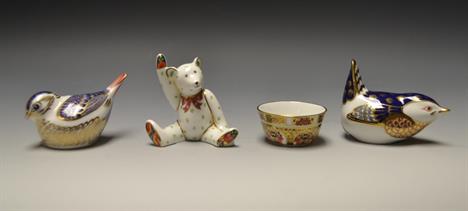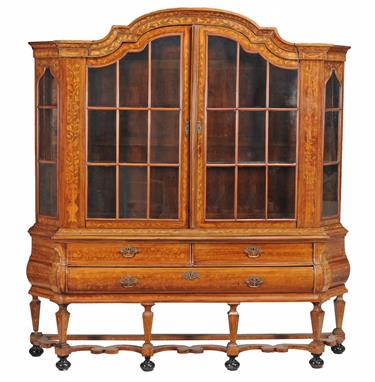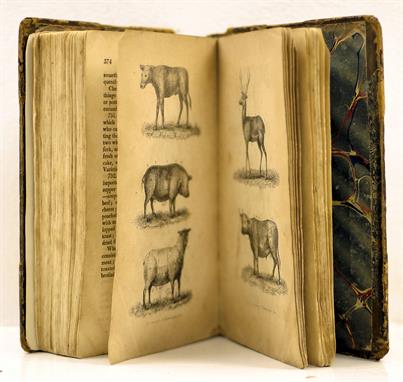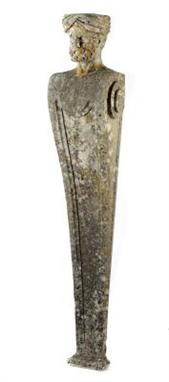INDIA - RARE PUNJAB SIKH WAR JOURNAL 1849 - Leaves from the Journal of a Subaltern, During the Campaign in the Punjaub, September 1848 to March 1849, 1849, first edition, 227pp, original embossed cloth. 1849 [Daniel August Sandford], Blackwood, An account of Sandford`s experiences as a member of the 2nd European Regiment during the Second Sikh War. He fought at the battles of Ramnuggur, Chilianwalla and Gujerat, against "those rascally Sikhs", but found time to play cricket whenever possible, and he provides vivid and evocative accounts of the heat of battle, the hails of bullets and shells, and the sight of the dead and injured at these hard-fought actions. Sandford also touches on the rigours of military life - `We have not had any pay issued for three months. Our servants hardly get food enough to keep them alive.`
We found 596772 price guide item(s) matching your search
There are 596772 lots that match your search criteria. Subscribe now to get instant access to the full price guide service.
Click here to subscribe- List
- Grid
-
596772 item(s)/page
INDIA - PUNJAUB BY COLONEL STEINBACH 1846 - The Punjaub; being a Brief Account of The Country of the Sikhs, Its extent, History, Commerce, Productions, Government, Manufacturers, Laws, Religion, etc., by Lieut-Colonel Steinbach, 1846, second edition, 183pp, original cloth. Scarce. Lieut. Colonel Steinbach, late of the service of Maharajah Runjeet Singh and his Immediate Successors. London; Smith, Elder and Co.; 1846; 8vo; colorized frontis fold-out map. Original cloth binding, Map has a couple of short closed tears and creases along extremities. A most rare and firsthand account of an officer who served in the Sikh Kingdom at Lahore but defected after the First Anglo Sikh war. A fine copy.
Thimbles - a Royal Crown Derby porcelain thimble stand pin cushion, containing assorted pattern thimbles, including Imari, etc; A Royal Crown Derby paperweight, Dormouse, gold stopper, first quality, boxed, another; Imari Dormouse, gold stopper, first quality, boxed (2); A Royal Crown Derby paperweight, Spaniel, gold stopper, first quality, boxed; another, Posie Spaniel, gold stopper, first quality, boxed (2)
YUN XI (Chinese, 1711-1758) Two birds on a branch The signature reads Painted by Yu Xi with respect With Huanghuali wood scroll weights Note: Yun Xi was the twenty-first son of the Kangxi emperor. He was made a beizi (earl) in the eighth year of the Yongzheng era (1730), and soon became a beile (marquis). When Emperor Qianlong ascended the throne, Yun Xi was made Shen Junwang (the Duke of Shen). Provenance : From the estate of Lady Jocelyn Warner 56cm x 63cm
Three first period Worcester porcelain tea bowls and saucers and a slops bowl, printed in blue 'Mother and Child' pattern [4] Further Information The condition of the 3 saucers are good. There is very little in the way of damages on any of them, The only thing we have noticed were two very small chips to the rim of he base of the saucer which is hardly noticeable. The blue painted pattern is also in good condition showing very little sign of age or wear. It is only on the rims of the saucers that it shows any sort of fading and even then it is only very minor. The 3 bowls are again in good condition. Two are without any significant damages if any at all. There may be the odd minor chip similar to the saucers. The blue painted pattern is similar to that of the saucers. The condition of the slops bowl is similar to that of the rest of the lot. Very little noticeable damage and paint work also in good condition.
A pair of Royal Crown Derby bone china ornamental ewers, painted and gilt in the Old Imari palette, pattern no 1128, printed mark to the underside, date coded, 25.5cm high Further Information The condition of this lot is excellent. No damages of flaws to comment on. No cracks, chips of loss of gilding etc. The lot appears to be a First. The back stamped is as it should be.
A pair of Royal Crown Derby bone china ginger jars and covers, painted and gilt in the Old Imari palette, pattern no 1128, printed mark to the undersides, differently date coded, 11cm high Further Information The condition of this lot is good to very good, There are no damages to either jar from what we can see and the gilding appears to be in good condition with no loss in any area. We believe the item to be first quality as the back stamp appears as it should be with no scratch through it or near it.
A two strand graduated pearl necklace with 9ct gold clasp Further Information The first 3 pearls at each side of the clasp have knots in between them. There are no further knots on the remainder of the necklace. Box is included in this lot. It is marked Liberty London-Paris on the inside and condition is fair.
§ Reg Gammon RWA (1894- 1997) Irish `Kelp Harvest, Brittany` oil on board signed New Grafton Gallery label verso , and Receipt dated January 25 1991 Reg Grafton ,Produced romantic and intensely coloured landscapes often speckled with peasant figures gypsies and itinerants working the land. 1985 he had a retrospective exhibition at the Royal West England Academy (RWA) and went on and held his first one man show aged 92. ARR (Artist Resale Right) is additionally payable on this lot. Please visit the DACS website (http://www.dacs.org.uk/home) or contact the auctioneer for more details. 17 x 23in. (43 x 58cm)
§ Reg Gammon RWA (1894- 1997) Irish `Workers in a yellow field` oil on board signed New Grafton Gallery label verso , and Receipt dated January 25 1991 Reg Grafton ,Produced romantic and intensely coloured landscapes often speckled with peasant figures gypsies and itinerants working the land. In 1985 he had a one man retrospective at the Royal West England Academy (RWA) and went on and held his first one man show aged 92. ARR (Artist Resale Right) is additionally payable on this lot. Please visit the DACS website (http://www.dacs.org.uk/home) or contact the auctioneer for more details. 21 x 29in. (53 x 74cm)
A Dutch walnut and marquetry display cabinet A Dutch walnut and marquetry display cabinet, first quarter 19th Century the arched and moulded cornice above a pair of astragal glazed doors and sides above two short and one long drawer tapering square section legs and a shaped undertier on ebonised bun feet 233.5cm high, 224cm wide, 47cm deep view on dreweatts.com
A South German marquetry cabinet on stand , first half 18th century A South German marquetry cabinet on stand , first half 18th century, probably Augsburg, the upper section of satinwood, rosewood and specimen timbers decorated with arabesque marquetry fitted with central cupboard surrounded by drawers inlaid with hunting scenes, on a stand fronted blackamoor figure supports, 128cm high, 76cm wide, 42cm deep view on dreweatts.com
A tole painted rectangular tray, the tray first half 19th century A tole painted rectangular tray, the tray first half 19th century, decorated with a butterfly surrounded by floral branches in gilt and polychrome, on an ebonised and parcel gilt stand, 20th century, of simulated bamboo design on turned tapering legs, 48.5cm high, the tray 68 x 58.5cm overall, together with a Victorian papier mache oval tray on later stand, the tray circa 1870, painted with floral branches and within mother of pearl inset detail and gilt borders, the simulated bamboo stand on cluster column legs centred by an X shaped stretcher, 45cm high, the tray 61 x 48cm overall view on dreweatts.com
A stained beech and upholstered sofa, first half 20th century A stained beech and upholstered sofa, first half 20th century, upholstered with Colefax & Fowler fabric, the shaped rectangular back and loose cushion seat above turned feet, 68cm high, 160cm wide, 74 cm deep view on dreweatts.com
A Russian walrus ivory and bone casket, Kholmogory, first half 19th century A Russian walrus ivory and bone casket, Kholmogory, first half 19th century, of rectangular form, with bands of carved arcading and green stained engraved decoration, on bracket feet, Arkhangelsk region, 12.5cm high, 23.5cm wide view on dreweatts.com
A George III mahogany triple folding combined games and tea table, circa 1760 A George III mahogany triple folding combined games and tea table, circa 1760, the rectangular top opening to the first tea section, then a baize inset section above a chess and inlaid backgammon section and opening to a well section, above a blindfret carved frieze, on fluted square section legs with a rear swing gateleg action, 75cm high, 81cm high, 40cm deep Provenance: A private European collection view on dreweatts.com
Reuben Sheppard , a bronze figure of a young girl Reuben Sheppard (exh. 1894-1914), a bronze figure of a young girl, standing and sheltering a small puppy in one arm, the integral tall pedestal with a lower freize of figures, animals and tennis racquets, signed in the maquette and dated 1907, deep brown patination, 43cm high Perhaps First Steps exhibited at the Royal Academy in 1909, no.1663. Another example sold these rooms 20th June 2006, lot 2336 view on dreweatts.com
A George II carved giltwood and marble mounted console table, circa 1750 A George II carved giltwood and marble mounted console table, circa 1750, in the manner of William Kent, the rectangular marble top, above a acanthus carved frieze, above central twin flower motif flanked by scrolling acanthus, on hipped s-scroll legs, jointed by conforming stretchers and on carved lion paw feet, 85cm high, the top 140cm wide, 94cm deep Provenance: A private European collection Following architectural style, furniture design underwent a revolution in the 1720s in response to the 3rd Earl of Burlington`s campaign to establish a new style based upon strict observance of the classical architectural rules and example of Andrea Palladio. Furniture design for the Palladian interior presented a particular problem as no precedent existed. The solution adopted by designers, in particular Burlington`s protégé William Kent (1685-1748), was to adapt and apply classical architectural features to established furniture types. Kent was "the first English architect to take a serious interest in furniture and like Robert Adam later in the century he sought to establish a harmonious relationship between the architecture of a room and its furniture". However, other architects such as William Jones, Batty Langley and Robert Morris published furniture designs in Kent`s Palladian style. Kent rose from a humble background to become one of the most influential designers of the early 18th century. His relationship with Lord Burlington brought significant aristocratic and royal patronage and his influence on many of the country`s greatest houses, their interiors and gardens is immense. It is however, in his capacity as interior designer that he was most successful. His schemes and designs for furniture can be seen at Chiswick House, Kew Palace, Raynham Hall, Holkham Hall and Hampton Court. For designs of related tables, see Elizabeth White, Pictorial Dictionary of British 18th century Furniture Design, Antique Collectors Club, 1990. The designs for pier tables by William Jones for The Gentleman or Builders Companion of 1739, (page 262) bear similarities to the current table being offered in terms of overall design and in particular the use of carved lion paw feet. Further designs by William Jones and Batty Langley (see page 263) demonstrate designs of frieze that bear closer relation to the current table. view on dreweatts.com
A 1951 boxed Festival of Britain Crown together with six other commemorative crowns, 1953-1977, plus nine other commemorative £5 coins, two Britains first decimal sets and two other presentation packs of coins, two nickel brass £2 coins, a Britannia one ounce of silver, a boxed Elizabeth II souvenir medallion, a Kennedy part silver half dollar and two other coins.
A fine and rare William and Mary double-horizontal carved Portland stone and bronze sundial circa 1690 inscribed and constructed for latitude 52° 24’ N., bearing the Arms and motto of the Cornwallis family, signed Henricus Wynne Londini Fecit, the dial plate seated on three bronze bearings upon a Portland stone plinth with octagonal top and four volute supports with acanthus terminals flanking scallop shells, on moulded square base Sundial 69cm.; 27in diameter, plinth 130cm.; 51ins high The double-horizontal sundial, as the name implies, is a dual instrument, its principal features comprising a ‘double’ gnomon and complementary hour-scales on the dial plate. The primary instrument is the fiducial edge of the inclined or sloping part of the gnomon, which, when the sundial is correctly set, lies parallel to the earth’s polar-axis and aligned in the north/south plane of the meridian and the shadow of which indicates the time against the outer hour-scale on the dial plate, in hours and minutes. The secondary instrument is the sharp vertical edge of the triangular-shaped support to the gnomon, which lies in the axis of the observer’s zenith, and the shadow of which indicates the position of the sun at the point where the straight edge of the shadow intersects the hour-line on a planispheric projection of the celestial sphere, corresponding to the time indicated on the main dial. This observation provides various astronomical data, including the sign of the zodiac in which the sun is situated, the times of sunrise and sunset, the length of the day in terms of the number of hours in the day from sunrise to sunset, the altitude and azimuth (direction) of the sun, together with the means to determine the time when certain ‘fixed’ stars would transit the meridian. The Cornwallis double-horizontal sundial has a floreated gnomon, seated on a sheet-brass dial plate, which is affixed to a cast-bronze base by means of ‘hidden’ rivets. The dial plate is engraved with various scales and tables, the primary hour-scale in the outer ring being graduated in hourly, ten-minute, five-minute and one-minute intervals, within which there are inner rings calibrated to indicate direction in terms of azimuth or bearing. The planispheric projection is also engraved with an inner and outer hour-scale, to facilitate its use, being graduated with hour-angle divisions (meridians) and parallels of declination to the limits of 23½ degrees north or south of the celestial equator or equinoctial line. Two engraved arcs, representing the ecliptic, the apparent path of the sun, extend from the points where the 6 o’clock meridians or hour-circles cut the equinoctial and graze the north/south extremities of the projection at the tropics of Cancer and Capricorn. The signs of the zodiac are inscribed at their respective intervals along these two arcs. At the east/west extremities of the projection there are date-scales, graduated in months and days, whereby the date may be determined from an observation. Conversely, the date being known, the sundial may be readily be orientated and aligned in the meridian, without recourse to the more usual and protracted methods involved in setting up an ordinary common or garden horizontal dial. Other scales engraved on the dial include a semi-circular lunar hour-scale (situated within the arc of the inner hour-scale of the planispheric projection), by which the time may be deduced from an observation of the moon, and two sets of altitude scales, for use with a pair of compasses or dividers. The names of certain fixed stars are inscribed within the boundaries of these scales, together with the values of their respective hour-angles or angular distances measured eastwards of the so-called first point of Aries, the vernal equinox. On the planispheric projection this is the point, at the eastern extremity of the grid system,
A pair of rare Georgian carved Portland stone terms circa 1740 160cm.; 63ins high These would originally have formed part of a larger architectural fitting either as jambs of an important chimney piece or jambs for an imposing door casing. Terms in the form of classical busts on a tapering pedestal originated in Roman times, representing the god terminus and were used for marking the boundary of an area or estate. Revived in Italian renaissance gardens, they were later adopted by William Kent, the 18th century architect and leading exponent of the Palladian style of architecture, named after the Venetian architect Andrea Palladio (1508-1580) and first introduced into England at Chiswick House, designed in conjunction with his patron Lord Burlington and finished in 1729. Kent was also a prolific designer of both landscape gardens and furniture, with term figures liberally used in both disciplines. His work was recently celebrated at an exhibition at the Victoria and Albert Museum William Kent: Designing Georgian Britain.
†The Crowther Collection: After John Van Nost: A lead sundial of a kneeling Moor 2nd half 20th century with octagonal lead dial 140cm; 55ins high A North American Indian and similar Blackamoor were originally made for Hampton Court by John Van Nost the Elder in 1701. They were perhaps originally intended as part of a larger set representing the Continents but for the death of William III two months after the erection of the first two.
A rare Coadestone armorial for the Founders Company stamped Coade and Sealy, Lambeth, 1800 124cm.; 49ins high by 94cm.; 37ins wide by 33cm.; 13ins deep Provenance: Most probably removed from the façade of the Founders Hall, London. The Worshipful Company of Founders is one of the oldest Livery Companies of the City of London, and can trace its existence back to 1365. It was formed to protect the interests of its members and to promote high standards of quality and workmanship in articles of bronze and brass. The first hall was built in 1531, when 18 members of the Company joined together to buy two houses and a garden in Lothbury and proceeded to build a Hall on a site which still bears the name of |Founders’ Court|. The Company was hard hit when the Hall, like so many others, was destroyed in the Great Fire of London in 1666 and rebuilt at a heavy cost mainly borne by the Liverymen from their own pockets. Built in brick with a stone front it is almost certain that this armorial was a later addition to the Hall and would have been positioned at parapet height on the façade, in the same position as a royal coat of arms, supplied in many cases by Eleanor Coade, for businesses which had received a Royal Warrant to supply some commodity or service. It would have been removed when the hall was demolished in the 1840’s to make way for a new Hall started in 1845. This piece would have been an individual commission and incorporates the Founders Company coat of arms which show a laver or washing ewer flanked by candlesticks reflecting the Founders who in the early days of the guild worked in brass and brass alloys or tinplate known as |Iatten| or |laton|, producing small cast articles. The top of the armorial incorporates a flaming furnace including a crucible from which the molten brass would have been poured into moulds. The lower portion with the bronze mortars and dolphin handles together with chain shot cannonballs normally used in naval engagements for destroying rigging on enemy ships, were very topical given the date of 1800 on this piece, since Britain was engaged in a maritime duel with Napoleon’s France for supremacy at sea which culminated in the battle of Trafalgar 5 years later in October 1805. The skill of the Coade modellers in faithfully reproducing in clay, the wooden carriage even down to the square iron strengthening plates and screws flanking the Coade stamp is testament to the quality to which Eleanor Coade aspired. This unusual Coade commission represents an opportunity to acquire a unique example from the best of the 18th century manufacturers and a piece of social history from one of the oldest and most august of the historical Livery Companies of London.
-
596772 item(s)/page




















![Three first period Worcester porcelain tea bowls and saucers and a slops bowl, printed in blue 'Mother and Child' pattern [4]](http://lot-images.atgmedia.com/SR/12268/2914236/165-20141017115917_468x382.jpg)


























